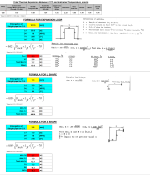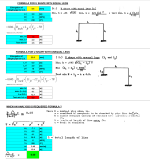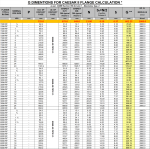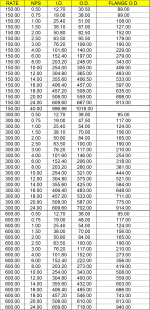Pipe Expansion Loop Calculations

Description
Pipe expansion loops, also known as expansion bends, are used in piping systems to absorb thermal expansion or contraction in the pipes. When a pipe heats up due to the flow of hot fluid, it expands, and when it cools down, it contracts. This thermal expansion and contraction can cause stress in the piping system, leading to damage or failure. To prevent this, engineers design pipe expansion loops.
There are several types of expansion loops, including U-shaped, L-shaped, and Z-shaped loops, as well as U-shaped loops with unequal legs. Each type of loop is designed to absorb a certain amount of expansion or contraction.
-
U-Shaped Expansion Loop: This is the simplest type of expansion loop. It consists of a U-shaped bend in the pipe, with two parallel legs of equal length. The U-shaped loop allows the pipe to expand and contract along the length of the loop, reducing stress in the piping system.
-
L-Shaped Expansion Loop: This type of loop is similar to the U-shaped loop, but it has a right-angle bend instead of a U-shaped bend. The L-shaped loop allows the pipe to expand and contract in two directions, which can be useful in systems where space is limited.
-
Z-Shaped Expansion Loop: This type of loop has two parallel legs like the U-shaped loop, but it also has a third leg that runs perpendicular to the other two. The Z-shaped loop allows the pipe to expand and contract in three directions, providing even more flexibility than the U- or L-shaped loops.
-
U-Shaped Loop with Unequal Legs: This type of loop is a variation of the U-shaped loop, but with one leg longer than the other. This design allows the loop to absorb more expansion or contraction in one direction than the other, which can be useful in systems where the thermal expansion or contraction is not symmetrical.
When designing an expansion loop, engineers must consider several factors, including the temperature of the fluid, the material of the pipe, the length of the pipe, and the amount of space available for the loop. The design of the loop must ensure that the stress in the pipe due to thermal expansion or contraction is below the allowable stress for the pipe material.
-
Thermal Expansion or Contraction: The change in length of the pipe due to thermal expansion or contraction can be calculated using the formula:
Delta L = L * alpha * Delta T
where:
- Delta L is the change in length,
- L is the original length of the pipe,
- alpha is the coefficient of thermal expansion for the pipe material, and
- Delta T is the change in temperature.
-
Stress in the Pipe: The stress in the pipe due to thermal expansion or contraction can be calculated using the formula:
sigma = E * alpha * Delta T
where:
- sigma is the stress,
- E is the modulus of elasticity for the pipe material, and
- alpha and Delta T are as defined above.
-
Flexibility of the Loop: The flexibility of the loop, which determines its ability to absorb thermal expansion or contraction, can be calculated using the formula:
f = Delta L / L
where:
- f is the flexibility,
- Delta L and L are as defined above.
These equations provide a starting point for the design of pipe expansion loops. However, the actual design process can be quite complex and may require the use of computational tools or software. It's also important to note that these equations assume a linear relationship between temperature and expansion, which may not be accurate for all materials or temperature ranges.
Calculation Preview
Full download access to any calculation is available to users with a paid or awarded subscription (XLC Pro).
Subscriptions are free to contributors to the site, alternatively they can be purchased.
Click here for information on subscriptions.







